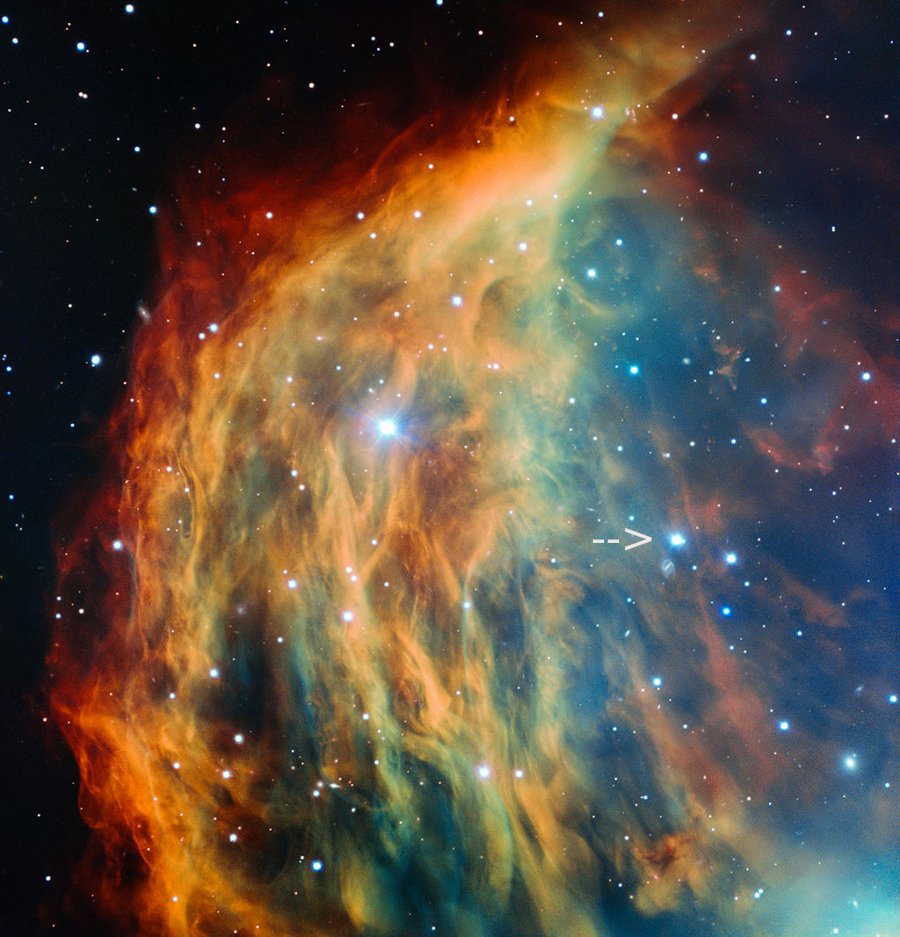johnnydeep wrote: ↑Fri Mar 26, 2021 7:26 pm
Ann wrote: ↑Fri Mar 26, 2021 6:56 pm
I found the arrow pointing to that star too, Johnny. It is
here.
But I don't feel convinced that the annotation is correct. The picture that was an APOD on June 12, 2015, is an ESO picture. But if you go to
ESO's original page about the Medusa Nebula, you can't find the arrow pointing out that star on that page, or at least I can't.
My guess is that it is another star that is the culprit:
I have marked the star that I consider to be the most likely candidate as the central star of the Medusa Nebula. I have picked it because it is the bluest star in the picture, and we expect central stars o planetary nebulas to be very hot and therefore blue.
The star that is the ionizing star of the Medusa Nebula is TYC 776-1339-1. But I have to admit that I could be wrong in identifying TYC 776-1339-1 as the bluest star in the ESO image.
There is a picture of TYC 776-1339-1 on a
SIMBAD page, and I don't think that the star that we see at SIMBAD really looks like the very blue star in the APOD. The nebulosity around the star in the APOD doesn't look the way it does at SIMBAD.
So maybe it really is the star by the arrow in the picture you posted, Johnny.
Ann
The SIMBAD pic (which is zoomable!) identifies the brightest star in today's APOD as TYC 776-1339-1:
As for the progenitor of the Medusa Nebula, it's either the one pointed to by the white arrow in the ESO pic, or it's the one pointed to by your blue arrow and my red arrow (which point to the same star),... or, it's a different star.

If the star at the green cross in the interactive AladinLite view is TYC 776-1339-1, then I'd say that TYC 776-1339-1 is definitely not the ionizing star of the Medusa nebula.
For one thing, it is too bright, bright enough to have a Tycho designation. And it's not particularly blue, and, worse, it's not strikingly ultraviolet.
I checked what Wikipedia would write about the well-know Helix Nebula, to see if it would mention the Helix's central star. Bear in mind that the Helix Nebula is at a distance of some 700 light-years (or even a bit closer), making the Medusa Nebula more than twice as distant from us as the Helix.
So you would expect the central star of the Helix Nebula to be a bit brighter, or at least as bright, as the central star of the Medusa Nebula.
Well, lo and behold. My software, Guide, identifies a stellar source at the center of the Helix Nebula, which is faint 14th magnitude. Bear in mind that TYC 776-1339-1 is an 11th magnitude star.
I tried to find out some more about the Helix's central star.
Wikipedia has extremely little to say about it. But I found
this paper that said that the designation of the central star of the Helix Nebula is WD 2226-210. Thanks to that designation, I could find the star on
Simbad.
Well, the star is a little brighter than my software gives it credit for, but it is still much fainter (in visible light) than TYC 776-1339-1. Also note that Simbad calls WD 2226-210 a planetary nebula, but it has nothing special to say about TYC 776-1339-1. In short, TYC 776-1339-1 is just an ordinary star, nothing special.
Also note how blue WD 2226-210 really is. Its brightness in ultraviolet is 11.894, its brightness in B is 13.158, and its brightness in V is 13.524. That's actually a whopping difference between B and V. No ordinary stars are that blue!
So, Johnny, I think you and I can agree that the central star of the Medusa Nebula is indeed the very blue star that both you and I singled out.
Ann
 The Medusa Nebula
The Medusa Nebula



